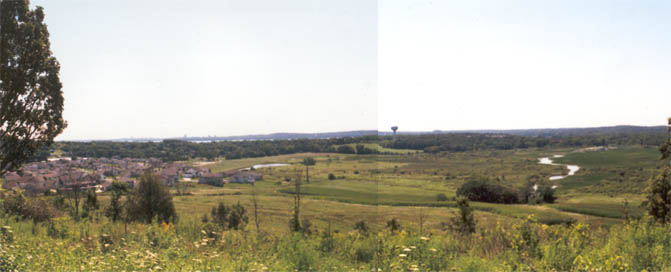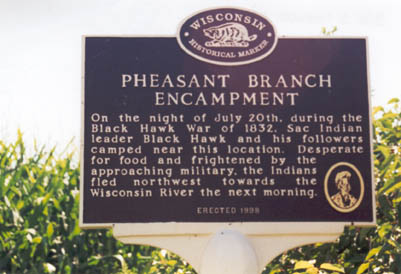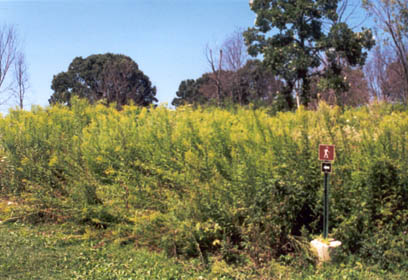
Image is overlooking Branch Creek. Black Hawk would have camped near the river. High ground would have allowed lookouts to observe the approaching militias.
Stop 3: Pheasant Branch Encampment
(Branch Creek Conservancy Park, Pheasant Branch Road, Middleton)
Take Wilson Street east past the Capitol
to Broom Street; turn right on Broom Street. Travel to University
Avenue; turn left on University Avenue. Drive until you reach
Allen Boulevard; turn right. At Century Avenue, turn left. At
Pheasant Branch Road, turn right. Branch Creek Conservancy Park
Parking Lot is just outside Middleton. Historical Marker #399.
Leave your car and walk into the park and climb the mound overlooking
the Branch Creek. Please stay on trail.
July 21, 1832
Black Hawk, Leader of the Sauk, writes:
During our encampment at the Four Lakes, we were hard put to, to obtain enough to eat to support nature. Situate in a swampy, marshy country,... there was but little game of any sort to be found--and fish were equally scarce... We were forced to dig roots and bark trees, to obtain something to satisfy hunger and keep us alive! Several of our people became so much reduced, as actually to die with hunger!... I concluded to remove my women and children across the Mississippi, that they might return to the Sac nation again. Accordingly, on the next day, we commenced moving, with five Winnebagoes [Ho-Chunk] acting as our guides, intending to descend the Ouisconsin [Wisconsin River].5
 |
(Click on image to see larger
version) Image is overlooking Branch Creek. Black Hawk would have camped near the river. High ground would have allowed lookouts to observe the approaching militias. |
| While Dodge and Henry's troops camped in what is now Monona, Wisconsin, Black Hawk had moved the majority of his people across the isthmus and camped on the Branch Creek in what is now Middleton. Black Hawk sent some of his warriors to high areas around the camp to alert Black Hawk of the approaching soldiers. Black Hawk expected to be attacked at the Branch Creek, but the troops had rested at Lake Monona. |

|
Here are a few more images of what the Branch Creek Conservancy Park looks like now.

|
Images are along the trail running through part of the Prairie Restoration areas.
|
|
|
Tip: Please stay on the trail. Wild grasses and wildflowers can be very fragile.